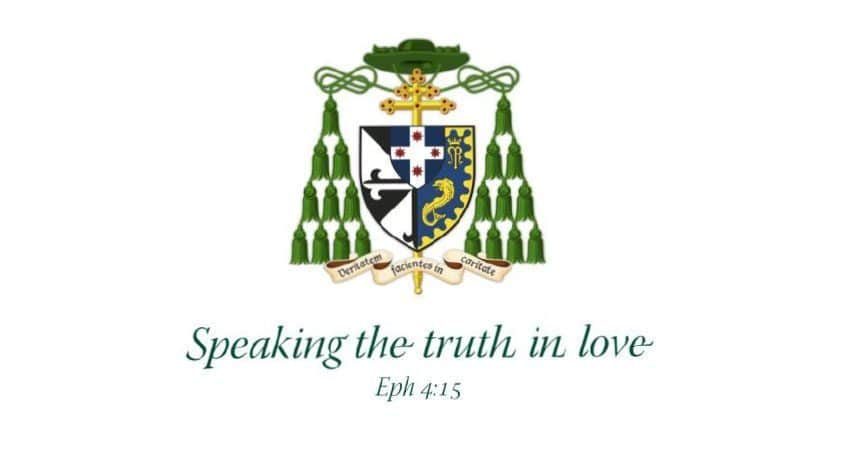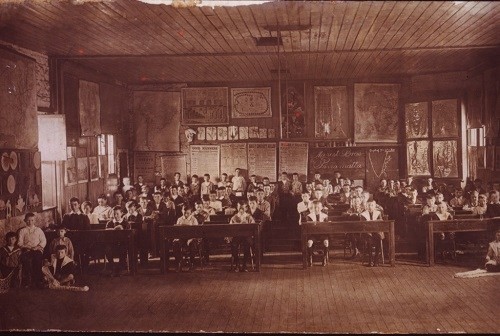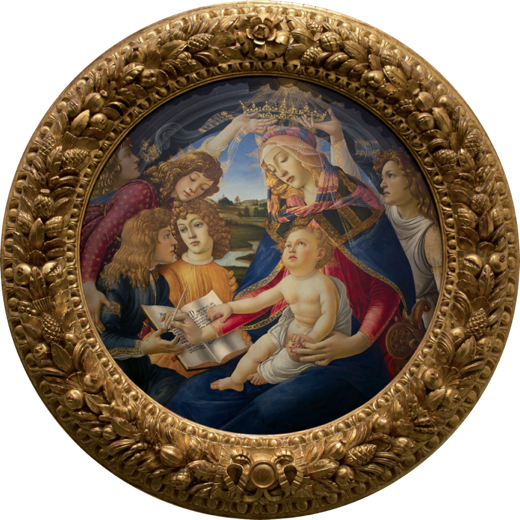HOMILY FOR MASS FOR THE BICENTENARY OF CATHOLIC EDUCATION IN AUSTRALIA

St Mary’s Cathedral, Sydney, Solemnity of Our Lady Help of Christians, 24 May 2021
Two hundred years ago Frs Philip Connolly and John Joseph Therry were appointed the first Catholic chaplains to the colony. They’d barely arrived when they started building the first chapel to Mary Help of Christians on this site and the first Catholic school in Parramatta. The school was already operational by January 1821, with 31 pupils and Mr George Morley (or Marley) their teacher.

That school was open to all, not just to Catholics, as has been the policy of Catholic education in Australia ever since. As the settlers spread through the continent, they brought with them their religious and educational aspirations, and by 1839 there were already 19 Catholic schools in NSW alone.
Until large numbers of religious arrived, lay people staffed these parish schools, often in a single room, with boys and girls or different levels separated by a curtain. Eventually certified teachers in registered Catholic schools were paid modest salaries by the government, and crown land provided for some church schools. But with enduring sectarianism and rising secularism, the mood turned against them. Funding for Catholic teachers ceased and by 1880 the imposition of “free, compulsory and secular” state schools put Catholic education in real jeopardy.

Today’s Feast speaks very directly to that absolutist secularism. The forces of the French Revolution and Napoleon sought to stamp out Catholicism in Europe by closing churches, convents and schools, replacing the Christian God with that of the Enlightenment. Napoleon jailed both Pope Pius VI (who died in prison) and then Pius VII. When Europe looked like falling to the secularists, the Holy Father called upon the faithful to pray the Rosary, just as his name-saint Pius V had done two centuries before when Europe was on the verge of falling to the Muslim empire. Pius VII vowed that, if Mary’s intercession saved them, he would dedicate a feast to her, under the title ‘Help of Christians’, just as his predecessor had instituted a feast of ‘Our Lady of the Rosary’. In answer to those prayers, the Pope was liberated on this day in 1814 which he then decreed the Feast. Catholicism would survive the assaults of secularism and, when Fr Therry was looking for a patron for the local Church and country, Our Lady Help of Christians seemed ideal.
Like Pius VII and their heavenly patroness, the Catholic community in Australia resisted secularisation. Archbishop Roger Bede Vaughan was outspoken in defence of Catholic education against ‘godlessness’ and sectarianism. The bishops, clergy, religious and lay faithful were equally resolute, as they committed to giving families the choice of a Catholic school in every town and suburb. With the arrival of nuns, brothers and clerical religious from overseas and the advent of some home-grown orders, religious built, led and staffed most Catholic schools with the help of lay staff and benefactors. By the 1960s, however, these schools were struggling to keep up the facilities and teacher-student ratios now expected for Australian schools. Only by securing state aid was this possible, and today Catholic education is very much a partnership between Church, families and the community.
Fr Therry, Bishop Polding and St Mary MacKillop could never have imagined that after two centuries Catholic education in Australia would have grown to the point that it now educates thousands of pre-schoolers in Church-sponsored early learning centres; around 770,000 (or 1 in 5) primary and secondary school students, in more than 1750 schools, with nearly 100,000 staff; 200,000 Catholic children in government schools through special religious education provided by catechists; around 50,000 post-schoolers on the several campuses of our Catholic universities or the other tertiary institutions; and thousands more are provided for in Catholic chaplaincies and residential colleges in state universities. Thus the Church in Australia today engages in education ‘from womb to tomb’ or at least from ‘P to T’ (pre-school to tertiary) assisting over a million students. It is an extraordinary achievement!
It has often been said that Catholic schools are the jewel in the crown of the Church in Australia, with few parallels overseas. Alongside families and parishes they are the principal meeting point of our Church with you, our young people. There many of you encounter Christ, intensify your knowledge and love of God, and are formed as future leaders and contributors to Australian society and to the building of God’s kingdom.
Catholic schools are also a major part of Australia’s educational ecosystem and social capital. They are mostly the equal of other schools regarding programs, outcomes, professionalism, facilities and innovation. Steadfast in their commitment to excellence and equity, they’ve given millions of young Australians of diverse backgrounds a high-quality education and raised many from the bottom of the social pile. In the process they’ve helped nurture a more just, prosperous and cohesive society.
On the face of it, our first reading presents a rather old-fashioned picture of the perfect wife and mother (Prov ch. 31) – not one we’d dare propose in a modern Catholic girls’ classroom! Yet if we delve more closely into the text, we may find it speaks to something of what has been and still is offered by and to young women in Catholic education.
The woman of Proverbs, whom our Feast identifies with Mary herself, is praised not for her charm or beauty – for these, the text warns, are conceits – but for her strength and character, her wisdom and reputation, and her sheer drivenness. No ‘kept woman’ this, she oversees the household, is the lynchpin of the domestic economy, and is a businesswoman in her own right, dealing in real estate, agriculture and the rag trade. She feeds her family and the poor. As a leader, we are told, she looks confidently to the future, and as a teacher she schools others in love and kindness.
If our first reading offers an inspiring vision for education, work and family by women and for young women, our second reading is addressed to ‘wise and learned men’ (Jas 3:13-18) and presumably men-to-be. It, too, lauds good lives over ‘earthly, animalistic and devilish’ ones, humble service more than self-seeking ambition, wisdom over cunning, compassion and truth instead of hypocrisy and bias, peace-making over grudge-bearing. Mary’s Magnificat in our Gospel presents a similar pattern for life in God’s kingdom for students and teachers (Lk 1:39-56): exulting in God, standing with the lowly, nourishing the disadvantaged, trusting in the promises that truth, goodness and beauty will ultimately triumph, and co-operating in bringing that about.
Because Catholic schools aim to cultivate these very qualities in their young people, it’s unsurprisingly so many of their graduates go on to put their character, skills and knowledge at the service of others in politics or law, as leaders of industry, professions or trades, as spouses and parents, volunteers and parishioners, as teachers or nurses, priests, nuns or brothers.
So today we celebrate the rich legacy to which we are heirs, borne of inspiring vision, unwavering resolve and sheer hard work. The bicentenary of Catholic education in Australia invites us to remember the past with gratitude, be inspired by that story in the present, and look forward with faith in the future. But there must be no complacency: we must focus more than ever on ‘the Catholic difference’ including transmission of faith, on access and enrolments, and on educational opportunity and excellence. After two centuries of service, we in Catholic education are determined to make an even greater contribution to the lives of our young people, families, church and society. Happy 200th birthday Catholic education! Our Lady of Help of Christians, pray for us!
WORD OF THANKS AFTER MASS FOR THE BICENTENARY OF CATHOLIC EDUCATION
Why did we do it? Why over the past two centuries did the Catholic community in Australia build the biggest Catholic education system per capita in the world? Because, my young friends, because we love you: God loves you, the Church loves you, your families love you, and the Australian community love you. If the Church through her parishes, our parents and the wider community have invested hugely in schools in this country, it is because you matter so much to us.
My thanks to so many who have contributed to this very happy celebration: the Bishops of Australia for their pastoral letter and Prime Minister for his message; Her Excellency the Governor, the Hon. Minister for Education and other distinguished guests; Hon. Jacinta Collins, Mrs Kathy Campbell and team from the NCEC who planned our bicentenary celebrations; other education leaders or representatives of sponsor congregations and PJPs; Mr Farley and all the leaders, staff and students from our Sydney Catholic Schools, including the students who assisted with the processions, readings and music; and the Cathedral staff, my MC Fr Lewi, the concelebrants, ministers and choristers, for our beautiful liturgy.
I don’t expect to be here for the 250th jubilee celebrations! But some of you who are here today will be. Some of you might by then be amongst our senior education leaders and teachers. But whatever you end up doing, try to remember this day and to tell people about it come the next jubilee. To all those who have joined in this very special celebration of the Bicentenary of Catholic Education in Australia: Ad multos annos! Many more years to come!
Welcome to St Mary’s Basilica in Sydney for our national Mass to mark the bicentenary of Catholic education in Australia, which is being celebrated more or less simultaneously across the cathedrals, parishes and schools of Australia. Two centuries ago the first officially sanctioned Catholic school in Australia was established by the newly arrived Catholic chaplain to the colony, Fr John Joseph Therry. He also built the first Catholic chapel dedicated to St Mary, Help of Christians, on this site, which became Australia’s first Catholic cathedral. After the devastating fire of 1865 it was rebuilt as one of the great cathedrals of the world, dedicated to St Mary the Immaculate Mother of God and Help of Christians. So it is very fitting that we celebrate the national bicentennial Mass on her feast day in her cathedral church in a country also under her patronage.
From civil society I am pleased to acknowledge Her Excellency Hon. Margaret Beazley AC QC, Governor of New South Wales and Mr Dennis Wilson; Hon. Sarah Mitchell MLC, Minister for Education and Early Childhood Learning in New South Wales, who represents our state government; Hon. Courtney Houssos MLC representing the Leader of the state opposition Ms Jodi McKay MP; and other civic leaders;
From Catholic pre-schooling I salute: Ms Franceyn O’Connor, Chief Executive Officer Sydney Catholic Early Childhood Services;
From Catholic primary and secondary education: Mr Nicholas Moore FCA, Chair of the National Catholic Education Commission with other commissioners; Hon. Jacinta Collins, Executive Director of the NCEC and staff; Mr Stephen Sedgwick AO, Chair of Catholic Schools NSW with other board members; Mr Dallas McInerney, Chief Executive Officer of CSNSW with his staff; Dr Brian Croke, past Director of the Catholic Education Commission of NSW; Very Rev. Gerry Gleeson VG, Chair of the Board of Sydney Catholic Schools, with other board members; Mr Tony Farley, Executive Director of SCS, Mr Anthony Cleary, Director of Mission and Identity, with other leaders and staff; Br Kelvin Canavan FMS, Emeritus Executive Director of SCS; principals, teachers, staff and students of the 170 Sydney Catholic Schools; leaders and representatives of Religious Institutes and PJPs that sponsor Catholic schools; and representatives of Catholic School principals and parents associations;
From our catechists who provide Special Religious Education in government schools: Ms Alison Newell, Chair of the Catholic Conference of Religious Educators in State Schools and Diocesan Coordinator for Broken Bay; Mr Doug Mawhinney, CCD Coordinator for Sydney; and other leaders, staff and catechists;
From Catholic tertiary education: I recognize Prof. Zlatko Skrbis, Vice-Chancellor and President of the Australian Catholic University, with Fr Anthony Casamento CSMA Vice-President, Members of Senate and other officials; Prof. Pauline Nugent AM, Provost, and Prof. Elizabeth Labone, Executive Dean of Arts, Science, Law and Business in the University of Notre Dame Australia, with Board Members and other officials; Dr Paul Morrisey, President of Campion College Australia; Professor Gerald Fogarty, Master of Warrane College in the University of New South Wales; Professor Sr Isabell Naumann ISSM , President of the Catholic Institute of Sydney; with other leaders and staff of the various Catholic tertiary institutions;
From other parts of the Church: Archdiocesan Chancellor Chris Meney, Executive Director Finance Michael Digges; from Australian Catholic Superannuation, Board Chairman David Hutton and CEO Greg Cantor; representatives of Church agencies that intersect with education; and all others present today;
Concelebrating with me are: Most Rev. Terry Brady and Richard Umbers, Auxiliary Bishops of Sydney; Vicar General Very Rev. Gerry Gleeson; and brother priests;
Above all, a very warm welcome to the Students, Staff and Leaders of our 170 Sydney Catholic School communities who are joining us by live-streaming, and to other friends of Catholic education beyond!

